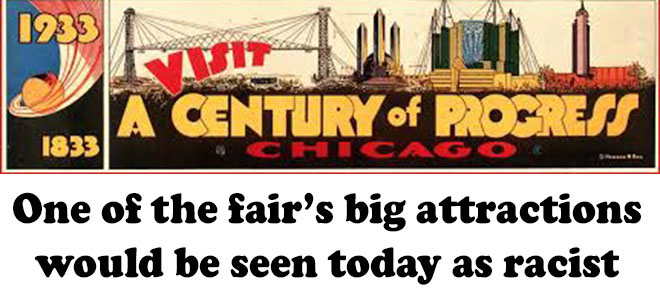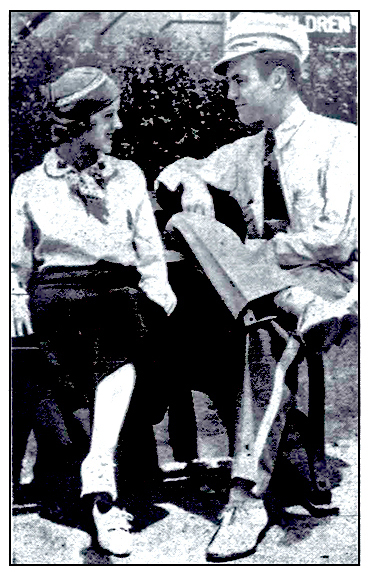| HOME • FAMILY • YESTERDAY • SOLVAY • STARSTRUCK • MIXED BAG |
 |
 |
A big, continuing story during most of 1933 was Chicago's world's fair, "A Century of Progress." One of the year's highlights was the mid-July visit of 24 Italian seaplanes under the command of General Italo Balbo, who, unfortunately for him, became one of the world's best-known aviators, making him immensely popular, especially in his home country. This made Italy's leader, Benito Mussolini, jealous, and Balbo would pay the price of stealing the spotlight from Il Duce. But that's a whole other story. This tale concerns one of the big daily attractions at the fair. The Sky Ride was an aerial tramway that carried passengers about one-third of a mile from one tower to the next in rocket-shaped cars that traveled about 23 stories (218 feet) above a lagoon, and on a clear day afforded an incredible view that carried far beyond Chicago. There were observation towers a the top of both towers that were 628 feet tall. There were 10 double-deck cars, each holding 36 passengers. In 1933, the cars carried 2,616,389 passengers. The fair resumed in 1934, but the novelty was wearing off, and the Sky Ride was taken down in 1935. Today the attraction would be heavily criticized by ultra judgmental wokesters because the Sky Ride towers were named Amos and Andy, and each car was named after a character in the "Amos 'n' Andy" radio show, which had originated on a Chicago station a few years before. Each Sky Ride car was named after a program character— Amos, Andy, Kingfish, Brother Crawford, Mrs. Crawford, Lightnin', Madame Queen, Ruby Taylor, Quindel or The Landlord (photo below). |
 |
The show's creators and stars were white performers Freeman Gosden and Charles Correll , who got their start as blackface comedians. They did most of the voices on the broadcasts in what eventually was regarded by Black actors took over when the program moved to television. Alvin Childress played Amos, Spencer Williams played Andy, with Tim Moore as the show's most outrageous character, Kingfish. Other memorable characters were Calhoun (Johnny Lee) and Sapphire (Samantha Wade.) However, the National Association for the Advancement of Colored People (NAACP) objected to the way the characters were portrayed. Had there been other programs featuring black performers playing doctors, lawyers, policemen, husbands, wives and parents, "Amos and Andy" might have been spared much of the criticism. After all, its characters were no more stereotyped than the white characters in "The Life of Riley" and "Duffy's Tavern" (which began every broadcast with a telephone call answered by the program's star, Ed Gardner, who said,, "Hello, Duffy's Tavern, where the elite meet to eat. Archie the manager speakin'. Duffy ain't here—oh, hello, Duffy.") I have no idea whether anyone complained about the Sky Ride's tribute to Amos and Andy — there were far greater issues in 1933 — and the only reason I know about this Chicago World's Fair attraction is because one of the people who worked at the Sky Ride was a man whose wife was killed in the city's most sensational murder that year. Rheta Gardner Wynekoop was the 23-year-old wife of ne'er-do-well mommy's boy Earle Wynekoop, whose job at the world's fair was the only one he had in his first 27 years. For a few months, he was a Sky Ride guide, but he spent most of his time at the fair pretending he was a single guy named Michael so he could freely flirt with young women, whose names, addresses, phone numbers and descriptive code were later found a notebook that provided police with interesting reading. Mrs. Wynekoop was shot and killed at home while lying on a table in a basement office of her mother-in-law, Dr. Alice Lyndsay Wynekoop, who confessed to the crime, then repudiated, then again admitted her guilt, only to deny it again in an endless change of stories. However, she was convicted of murder and spent several years in prison. The murder occurred November 21, 1933. By that time of year, the World's Fair was closed for the winter, and Earle Wynekoop was unemployed, so he came up with a reason to be out of town when his mother made his a widower. (He claimed he was on his way to take photographs of the Grand Canyon.) This was one of the coincidence that convinced police Earle had helped plan his wife's murder. He was charged, but never convicted. |
While on the job, Earle met more than 50 women whose names he entered into his little black book. He told them his name was Michael, and, unless pressed, did not mention he was married. Apparently he was The caption explained he was Earle Wynekoop, widower of Mrs. Rheta Gardner Wynekoop, victim in what was called "Chicago's operating room slaying." The photo was taken while he was working at the World's Fair and known as "Sky Ride Mike." He is wearing the uniform of a Sky Ride guide. With him in the photo is Mary Gerken, a cashier at the exposition. She was questioned by police and convinced them she had never been involved with Wynekoop. The press had a field day with Earle Wynekoop's little black book, and settled on 50 as the number of girl friends he may have had, though there were more than 50 names in his date book. With each name was an address and a series of numbers, Earle Wynekoop code for a rating system. For example, after one girl's name were the numbers 2-4-9-10. These were later explained this way: (2) blonde, (4) pretty, (9) exhibit and (10) sentimental. Just what Wynekoop meant by those last two, I have no idea. |
| HOME • CONTACT |
 many as radio's most offensive show, though even its critics had to conceded it was very funny and very popular. It was about the daily lives of two friends who ran a Harlem taxi company.
many as radio's most offensive show, though even its critics had to conceded it was very funny and very popular. It was about the daily lives of two friends who ran a Harlem taxi company. quite a character at the fair, and a few days after his wife was murdered, this photo surfaced and appeared in several newspapers.
quite a character at the fair, and a few days after his wife was murdered, this photo surfaced and appeared in several newspapers.